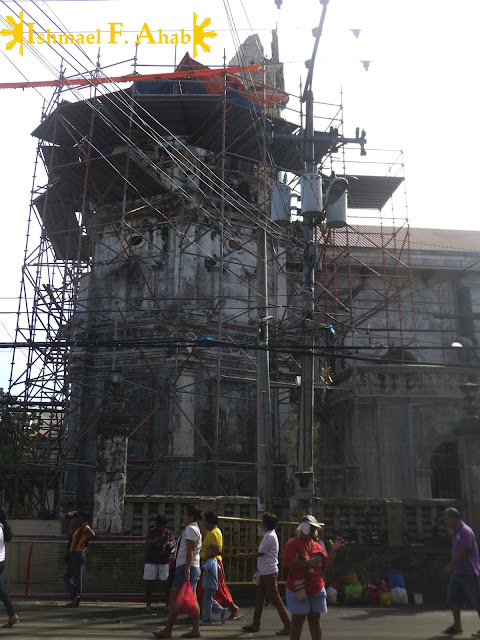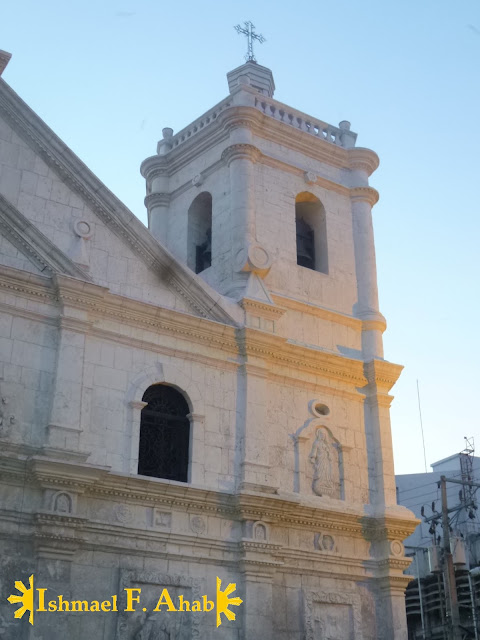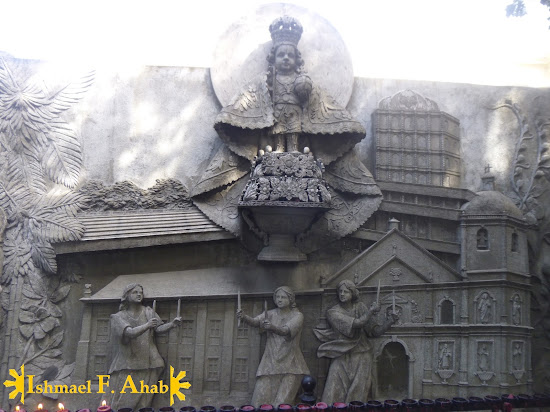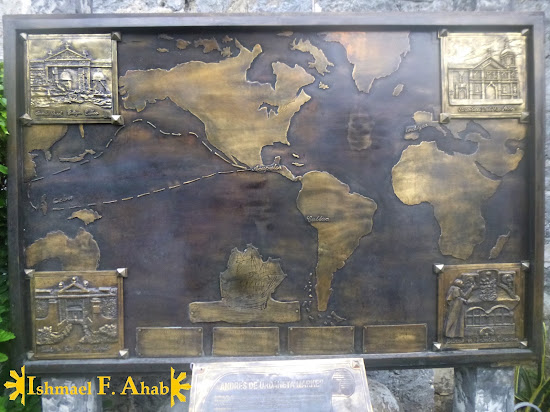In a partially burned hut, Juan found a pine box gilded with gold. The Spanish soldier opened the box, hoping to find some treasures hidden by indios. Alas! What he found is not gold or silver. What he found is something much more valuable: the image of the Santo Niño.
The accidental discovery of the holy image in Sugbu (now Cebu) is the beginning of Christianity in the Philippines.
According to historical accounts, the image of the Santo Niño discovered by Juan Camus was the same image given by Ferdinand Magellan to Rajah Humabon about 44 years earlier. The discovery of the image was seen as a divine sign by Spanish conquistador Miguel Lopez de Legazpi of their victory in the Philippines.
A church, made of wood and nipa, were immediately built on the very spot where the Santo Niño was discovered. The first church for the Santo Niño destroyed by fire and so was the second church that replaced it.
The stone church for the Santo Niño standing today is the third church structure and was finished around 1739.
This stone structure of the Basilica Minore del Santo Niño is not impregnable because it was almost destroyed by an earthquake. I have seen the ruins firsthand when I visited Cebu City in 2014, about 4 months after the devastating earthquake in Bohol.
The basilica’s bell tower collapsed and only half of it remained standing.
Good thing that the basilica is not off limits to visitors that’s I was able to enter it. However, masses have to be held outside of the basilica for the safety of Santo Niño devotees. I actually attended a mass at the open space fronting the Basilica.
The ruins of the Minor Basilica of the Santo Niño made the somber atmosphere in the area. Even the vendors around the basilica felt sad seeing their church in ruins.
The lively atmosphere around the Basilica is back during my visit to Cebu City in 2016. The Basilica was restored thanks to the help of the National Historical Commission of the Philippines.
The Basilica now has a new belfry.
Even the whole façade of the Basilica was restored and look new.
Devotees can now attend masses inside the Basilica and visit the Santo Niño without the fear of being buried under the rubble. Tourists like me can safely marvel at the beauty of the seemingly golden altar of the Basilica.
There is one painting inside the Basilica that I enjoyed looking at. It depicts the Santo Niño with his staff pointing towards Cebu.
The message of the painting is clear. It shows that Cebu is the center of Christianity in the Philippines. Cebu is the fertile land where the seeds of Faith took root and bear a hundredfold.
This is the reason why the Holy See declared the Basilica Minore del Santo Niño as Mater et Caput Omnium Ecclesiarum Insularum Philippinarum or the Mother and Head of All Churches of the Philippine Islands.
This declaration by the Church only shows the great importance of the Basilica and the Santo Niño to the Filipinos. They are the anchor of our faith and culture.
Aside from being the center of Catholic Faith and anchor of Filipino culture, the Basilica also serves as a landmark of World History. In front of the Basilica stands the bronze marker commemorating the journeys of Fray Andres de Urdaneta.
Urdaneta is the navigator of the Legazpi Expedition. He is also the first prelate of Cebu. He made a mark in world history for discovering the tornaviaje or the return route from Philippines to Mexico, which became the vital route of Spanish galleons during the great Galleon Trade.
Some historians said that children had special place in the heart of the indios that the Spanish met during the colonization of the Philippines. This is the reason why the Cebuanos readily accepted the Santo Niño in to their hearts. I believe that God, in some way, Christianized the whole country through His humility as a child.
---
Read about my previous visits to the Minor Basilica of the Santo Niño:
Minor Basilica of the Santo Niño (2010)
Inside the Basilica Minore del Santo Niño (2012)
---
Laag-Laag sa Cebu (Part 19): Temple of Leah - The House of Vanity
Laag-Laag sa Cebu (Part 18): A Better Stay in Bayfront Hotel in Cebu
Laag-Laag sa Cebu (Part 17): A Great View of Cebu City from Tops Busay
Laag-Laag sa Cebu (Part 16): A Taste of Mandarin in Cebu City
Laag-Laag sa Cebu (Part 15): Taboan the Pasalubong Center of Cebu City
Laag-Laag sa Cebu (Part 14) – My Accidental Visit to Mt. Carmel Church
Laag-Laag sa Cebu (Part 13): Another Visit to the Cebu Metropolitan Cathedral
Laag-Laag sa Cebu (Part 12): Why Cebuanos Call Mama Mary as Birhen sa Regla?
Laag-Laag sa Cebu (Part 10): A Visit to the Fake(?) Magellan’s Cross
Laag-Laag sa Cebu (Part 9): The Story of Rajah Humabon - King of Cebu
Laag-Laag sa Cebu (Part 8): Calle Colon, the Oldest Street in the Philippines
Laag-Laag sa Cebu (Part 7): The Worst Cebu Hotel
Laag-Laag sa Cebu (Part 6): The Colorful Lighthouse of Lilo-an
Laag-Laag sa Cebu (Part 5): The Mysterious Church of Lilo-an
Laag-Laag sa Cebu (Part 4): Bagacay Point Lighthouse
---
Read about my previous visits to the Minor Basilica of the Santo Niño:
Minor Basilica of the Santo Niño (2010)
Inside the Basilica Minore del Santo Niño (2012)
---
Read more of my latest adventure in the island of Cebu!
Laag-Laag sa Cebu (Part 19): Temple of Leah - The House of Vanity
Laag-Laag sa Cebu (Part 18): A Better Stay in Bayfront Hotel in Cebu
Laag-Laag sa Cebu (Part 17): A Great View of Cebu City from Tops Busay
Laag-Laag sa Cebu (Part 16): A Taste of Mandarin in Cebu City
Laag-Laag sa Cebu (Part 15): Taboan the Pasalubong Center of Cebu City
Laag-Laag sa Cebu (Part 14) – My Accidental Visit to Mt. Carmel Church
Laag-Laag sa Cebu (Part 13): Another Visit to the Cebu Metropolitan Cathedral
Laag-Laag sa Cebu (Part 12): Why Cebuanos Call Mama Mary as Birhen sa Regla?
Laag-Laag sa Cebu (Part 10): A Visit to the Fake(?) Magellan’s Cross
Laag-Laag sa Cebu (Part 9): The Story of Rajah Humabon - King of Cebu
Laag-Laag sa Cebu (Part 8): Calle Colon, the Oldest Street in the Philippines
Laag-Laag sa Cebu (Part 7): The Worst Cebu Hotel
Laag-Laag sa Cebu (Part 6): The Colorful Lighthouse of Lilo-an
Laag-Laag sa Cebu (Part 5): The Mysterious Church of Lilo-an
Laag-Laag sa Cebu (Part 4): Bagacay Point Lighthouse
Laag-Laag sa Cebu (Part 3): Feasting on Consolacion’s Fresh Talaba
Laag-Laag sa Cebu (Part 2): Finding Consolation in Consolacion Church
Laag-Laag sa Cebu (Part 2): Finding Consolation in Consolacion Church
.















Awesome, takes my breath away. So good that they restored it - here, they pull everything down and build those modern monstrosities. Not nice at all, no character and the heritage is lost. Sad.
ReplyDeleteIt is sad that many people nowadays no longer value heritage and the things that their ancestors built. No sense of history. It is one of the reasons why our society is in disarray.
DeleteIto pala ang church na nakta ko na gumuho dun sa video sa bohol. Astig
ReplyDelete